"Are sea ice conditions changing in the Arctic, and if so what changes are occurring, how do they vary regionally, and what are the effects on people?"
Workshop Purpose
The effects of variations in Arctic sea ice cover are direct and dramatic for those who live along the Arctic coast,. In other ways, they are indirect and subtle, such as through the influence of ice on oceans and weather. Sea ice conditions and trends have been the subject of detailed observation for centuries by indigenous peoples, and over the past hundred years by western civilization, beginning with the activities of whaling ships and extending through studies of the effects of shipping and mineral extraction in the Arctic. The relevance of the ice cover to global climate has, however, received increased attention recently as concerns grow about the causes and effects of climatic change.
Predictions of global warming generally find that changes in climate are greatest in the polar regions, and that reductions in ice cover are one of the most obvious and dramatic of these changes. Observations of ice cover, primarily from satellites during the past 20 years, suggest a general decrease in Arctic sea ice extent, but with large interannual and regional variations. Indigenous people report a variety of changes in ice conditions that may or may not be related to a general change in climate. For example, residents of Alaska's North Slope report thinner ice, later formation and earlier melt, less stable shore-fast ice, and a decreased presence of thick, old ice in recent years.
As this breadth of interest in Arctic sea ice cover suggests, observers and researchers have assembled a wealth of knowledge and information related to ice conditions. Significant gaps remain though, in our understanding of the long-term variations in ice cover, the effects of these changes, and the role of local versus large-scale weather and climate in controlling sea ice. Much remains to be learned about how best to use different types of knowledge, observations, and models to better predict sea ice changes. As the performance of models and satellite observing systems improve, it is important to define the types of predictions and monitoring that are most important for different human activities.
Discussion Structure
We have identified a few questions to set the stage for the discussion. The questions attempt to encompass the issues relating to changing sea ice and impacts on people. Under each question in the forum, participants may add topics of discussion or comment within existing topics. We hope you will feel free to comment and add new topics that cover issues not yet addressed.
We hope to identify:
- New or recent information available
- Evidence of changes in or related to sea ice
- The significant relationships and feedbacks
- The key unknowns
- What research is needed now to feel the gaps and to get better understanding
Discussion Themes
- How is arctic sea ice changing? Evidence from local, traditional, and indigenous knowledge, ice charting, satellite analyses and other observations.
- How do changes in sea ice relate to overall climate and climate change? A discussion of sea ice extent, concentration, thickness, and type, and the links between climatic factors affecting sea ice, global circulation and day-to-day conditions affecting sea ice.
- How do changes in sea ice affect physical processes? Physical impacts of sea ice and how these might change, for example, ocean-atmosphere heat transfer, brine generation, deep water formation, and large-scale transport of low-salinity water.
- How will changes in sea ice affect processes such as coastal erosion, to which coastal communities are vulnerable?
- How do changes in sea ice affect ecosystems, coastal conditions and habitat?
- How will changes in sea ice affect subsistence hunting practices, both through the availability of marine mammals and through access to hunting areas?
- What are the likely economic impacts of sea ice change on shipping, development, and other large-scale activities?
"Although climate change is often discussed in terms of gradual trends in temperature and precipitation, both indigenous knowledge and ice-core records paint a picture of more dramatically variable weather conditions."
–People and the Arctic: A Prospectus for Research on the Human Dimensions of the Arctic System.
Background
These figures appear courtesy of Jim Maslanik and the National Snow and Ice Data Center.
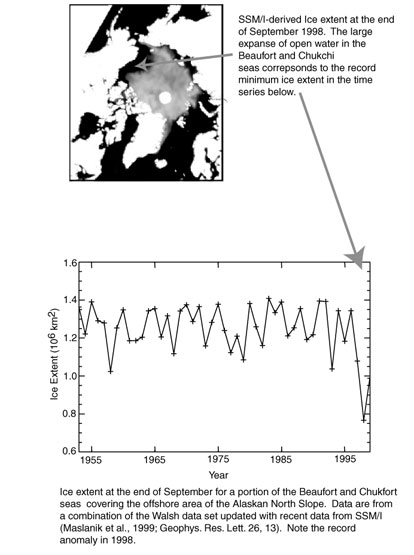
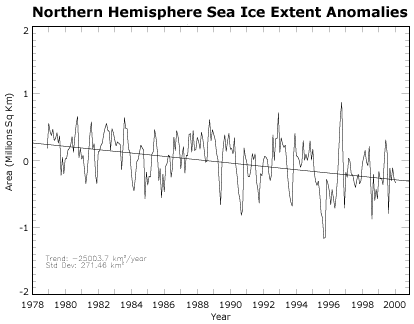
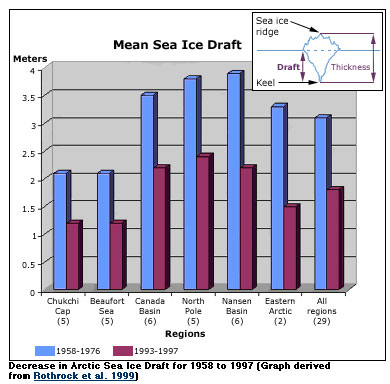
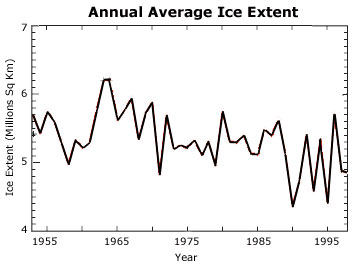
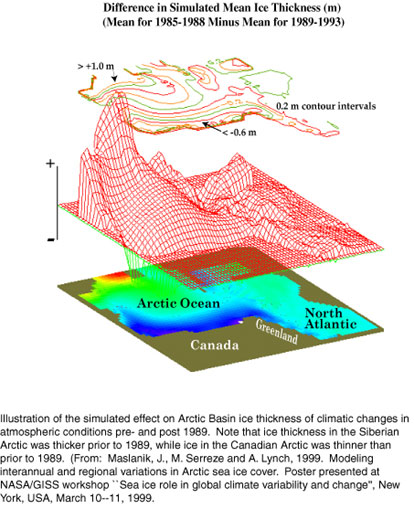
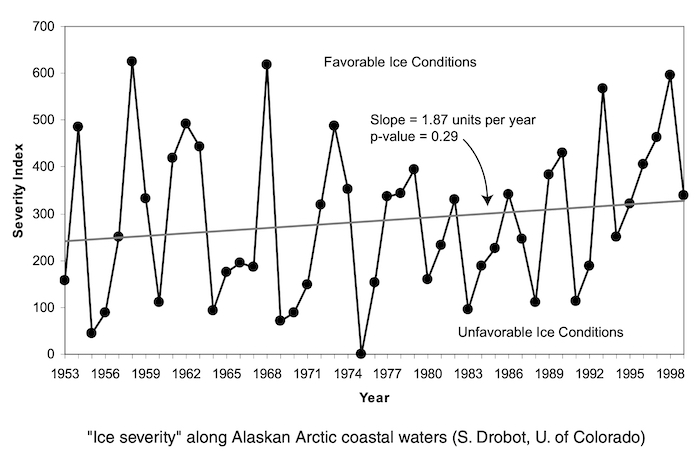
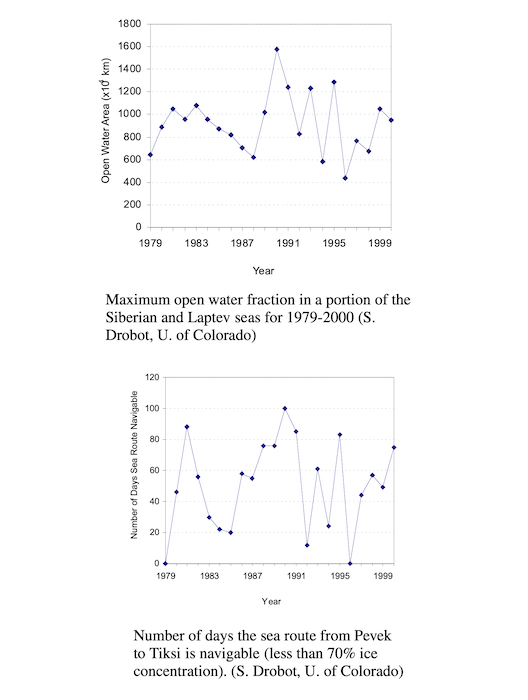
REFERENCES:
Bjørgo, E., O.M. Johanessen, and W.M. Miles, 1997: Analysis of merged SMMR-SSMI times series of Arctic and Antarctic sea ice parameters 1978-1995. Geophys. Res. Lett., 24, 413-416.
Brigham, L.W., 2001: The Northern Sea Route, 1999-2000. Polar Record, 203, 329-336.
Cavalieri, D.J., P. Gloersen, C.L. Parkinson, J.C. Comiso, and H.J. Zwally, 1997: Observed hemispheric asymmetry in global sea ice changes. Science, 278, 1104-1106.
Chouinard, L.E., L. Garrigues, and V.R. Neralla, 1995: Interannual variability of the ice cover of the Chukchi and Beaufort seas. Proc. 5th International Offshore and Polar Engineering Conference. The Hague, The Netherlands, pp. 357-363.
Deser, C., J.E. Walsh, and M.S. Timlin, 2000: Arctic sea ice variability in the context of recent atmospheric circulation trends. J. Climate, 13, 617-633.
Fang, Z., and J.M. Wallace, 1994: Arctic sea ice variability on a timescale of weeks and its relation to atmospheric forcing. J. Climate, 7, 1897-1914.
Jayne, S.R., and J. Marotzke, 2001: A destabilizing thermohaline circulation-atmosphere-sea ice feedback. J. Climate, 12, 642-651.
Johannessen, O.M., E.V. Shalina, and W.M. Miles, 1999: Satellite evidence for an Arctic sea ice cover in transformation, Science, 286, 1937-1939.
Kwok, R., Recent changes in Arctic ocean sea ice motion associated with the North Atlantic Oscillation, Geophys. Res. Lett., 27, 775-778, 1998.
Maslanik, J.A., M.C. Serreze and R.G. Barry, 1996: Recent decreases in Arctic summer ice cover and linkages to atmospheric circulation anomalies. Geophys. Res. Lett., 23, 1677-1680.
Maslanik, J.A., M.C. Serreze, and T. Agnew. 1999a. On the record reduction in 1998 Western Arctic sea-ice cover. Geophys. Res. Lett., 26(13), 1905-1908.
McPhee, M.G., T.P. Stanton, J.H. Morison, and D.G. Martinson, 1998: Freshening of the upper ocean in the central Arctic: Is perennial ice disappearing? Geophys. Res. Lett., 25, 1729 – 1732.
Melnikov, I.A., 1997: The Arctic sea ice ecosystem. Amsterdam: Gordon and Breach Science Publishers. 204 pp.
Niebauer, H.J., 1998: Variability in Bering Sea ice cover as affected by a regime shift in the North Pacific in the period 1947-1996. J. Geophys. Res., 103, 27 717-27 737.
Parkinson, C.L., D.J. Cavalieri, P. Gloersen, H.J. Zwally, and J.C. Comiso, 1999: Arctic seai ice extents, areas, and trends, 1978 – 1996. J. Geophys. Res., 104(C9), 20,837 – 20,856.
Parkinson, C.L., 2000: Variability of Arctic sea ice: The view from space, and 18-year record, Arctic, 53, 341-358.
Rogers, J.C., 1978: Meteorological factors affecting interannual variability of summertime ice extent in the Beaufort Sea. Mon. Wea. Rev., 106, 890 – 897.
Rothrock, D., Y. Yu, and G. Maykut, 1999: Thinning of the Arctic sea ice cover. Geophys. Res. Lett., 23, 3469 – 3472.
Serreze, M.C., J.A. Maslanik, J.R. Key, R.F. Kokaly and D.A. Robinson, 1995: Diagnosis of the record minimum in Arctic sea ice area during 1990 and associated snow cover extremes, Geophys. Res. Lett., 16, 2183-2186.
Stirling, I., and A.E. Derocher, 1993: Possible impacts of climate warming on polar bears. Arctic, 46, 240 – 245.
Tremblay, L.B., and L.A. Mysak, 1998: On the origin and evolution of sea-ice anomalies in the Beaufort-Chukchi Sea, Clim. Dyn., 14, 451-460.
Varley, M., 2001: Northern exposure. Geographical. 73, 48-53.
Volkov, N.A., Z.M. Gudkovich, A.A. Krillov, G. Kovalev, A.A. Smetannikova, and V.A. Spichkin, 1970: Main results and further work in the development of long-range ice forecasting methods for the Arctic seas. Problems in the Arctic and Antarctic. 36/37, 86 – 106.
Wadhams, P., and N. Davis, 2000: Further evidence of the ice thinning in the Arctic Ocean. Geophys. Res. Lett., 24, 3973 – 3975.
Walsh, J.E., and C.M. Johnson, 1979: Interannual atmospheric variability and associated fluctuations in Arctic sea ice. J. Geophys. Res., C11, 6915 – 6928.
Wang, J., and M. Ikeda, 2000: Arctic Oscillation and Arctic Sea-Ice Oscillation. Geophys. Res. Lett., 27, 1287 – 1290.
Yang, J., and D.J. Neelin, 1993: Sea-ice interaction with the thermohaline circulation. Geophys. Res. Lett., 20, 217 – 220.
Zhang, J., D.A. Rothrock, and M.S. Steele, 2000: Recent changes in Arctic sea ice: The interplay between ice dynamics and thermodynamics, J. Climate, 13, 3099-3114.
